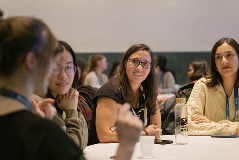Magic angle enables magnetoelectric switching in multiferroic
Sep 30, 2022|Season 4, Episode 17
In this podcast episode, MRS Bulletin’s Laura Leay interviews Sergey Artyukhin from the Istituto Italiano di Tecnologia and Louis Ponet, who is affiliated with both the Istituto Italiano di Tecnologia and Scuola Normale Superiore di Pisa about a topologically protected switching phenomena in ferroic materials. When a multiferroic crystal (GdMn2O5) is placed in a magnetic field at a very particular angle to a crystallographic axis, and the magnetic field is swept up and down twice, the system switches between four magnetic configurations. The interplay between the spin of the gadolinium and manganese ions leads to a unidirectional rotation of the spins and because this rotation is caused by the up-down sweep of the magnetic field, it can be thought of as a crankshaft. This four-state magnetoelectric switching emerges as a topologically protected boundary between different two-state switching regimes. While this magnetoelectric switching has only been observed in one multiferroic material, modelling can help predict other suitable materials from first principles. Eventually this could lead to new technology. This work was published in a recent issue of Nature (doi:10.1038/s41586-022-04851-6).
LAURA LEAY: Welcome to MRS Bulletin’s Materials News Podcast, providing breakthrough news & interviews with researchers on the hot topics in materials research. My name is Laura Leay. Sometimes a really important discovery is made by chance, and one chance discovery could make a big difference to the energy efficiency of data processing and storage devices.
SERGEY ARTYUKHIN: A lot of energy is currently spent on data centers. There is a lot of energy for writing onto hard drives but also for cooling the data centers. That requires a lot of energy. It’s about 2% of all the electrical energy generated in the US. People are, kind of, fighting against fundamental bottlenecks and so new physical principles are needed to overcome this difficulty.
LAURA LEAY: That was Sergey Artyukhin from the Istituto Italiano di Tecnologia. Sergey works with an experimental team from Vienna University of Technology who observed something really unusual. It turns out that when a multiferroic crystal is placed in a magnetic field at a very particular angle to a crystallographic axis, and the magnetic field is swept up and down twice, the system switches between four magnetic configurations. Other angles don’t show such interesting behavior, as Louis Ponet, who is affiliated with both the Istituto Italiano di Tecnologia and Scuola Normale Superiore di Pisa, explains.
LOUIS PONET: Low and high angle just show, sort of, a normal behavior you would expect from a multiferroic material where you would just cycle between two states … but then when you are at this magic angle region you get this very weird four state switching behavior. We called it the magic angle because that’s like where the magic is happening, right.
LAURA LEAY: Experiments involved tilting the magnetic field at various angles away from the a-axis in the a-b plane of a gadolinium-manganese-oxide. The interplay between the spin of the gadolinium and manganese ions leads to a unidirectional rotation of the spins and because this rotation is caused by the up-down sweep of the magnetic field, it can be thought of as a crankshaft. No one thought this effect would be possible and it took some very careful modelling to understand what was seen experimentally.
LOUIS PONET: Trying to figure out the model itself was pretty tricky. There were some avenues we tried initially that didn’t work out. As soon as we understood that the model we wrote down can show this behavior, it was basically about trying to find the right model parameters which was a bit of trial-and-error.
LAURA LEAY: The experimental work involved dozens of cycles of the magnetic field at each angle tested, and were performed at an incredibly low temperature: just two Kelvin. Now that the phenomenon has been observed and understood, work can move towards room temperatures and to investigate whether applying an electric field can lead to the same behavior. Eventually this could lead to new technology.
SERGEY ARTYUKHIN: Usually engineers optimize these things after they are discovered for some time. Once you know the principles, usually it’s possible.
LAURA LEAY: This very unusual magnetoelectric switching has only been observed in one multiferroic material but the modelling can help predict other suitable materials from first principles.
LOUIS PONET: We also really have to understand, let’s say, how to derive the model parameters that we’re working with from purely ab initio calculations because then we could use those to do, let’s say, a search through lots of potential candidates.
LAURA LEAY: More materials could also be found experimentally by trying different angles between the magnetic field and the crystallographic axes.
LOUIS PONET: This region is sort of a topologically protected region between two others and these two other regions are very large, right. The high angle region is pretty big; the low angle region is pretty big. And so if the experiments do just, like, one high angle measurement, one low angle measurement, then probably there will be somewhere a magic angle where the four state switching appears.
LAURA LEAY: These findings are an important first step towards creating new, more efficient data handling devices and elegantly show how the significant effort in both mathematical modelling and experiment can lead to new understanding of really unusual behavior. This work was published in a recent issue of Nature. My name is Laura Leay from the Materials Research Society. For more news, log onto the MRS Bulletin website at mrsbulletin.org and follow us on twitter, @MRSBulletin. Don’t miss the next episode of MRS Bulletin Materials News – subscribe now. Thank you for listening.

